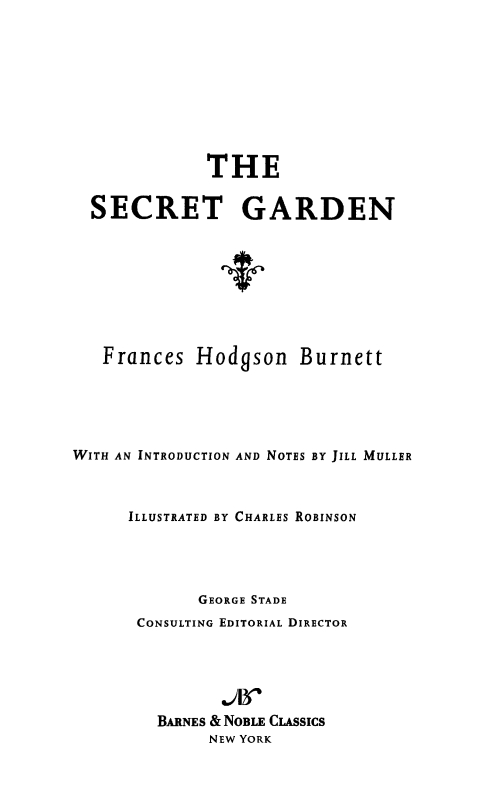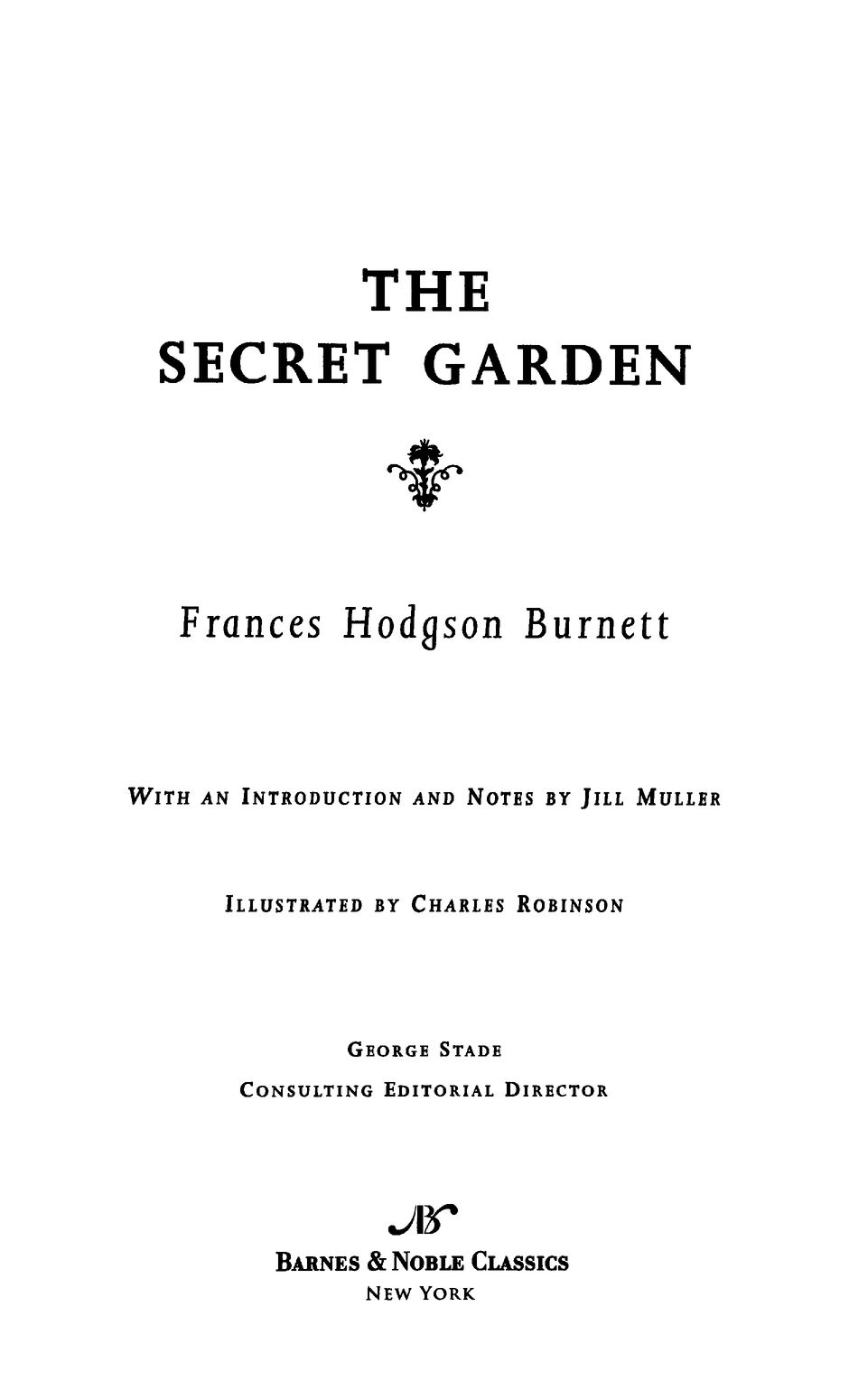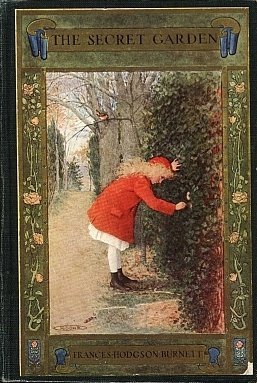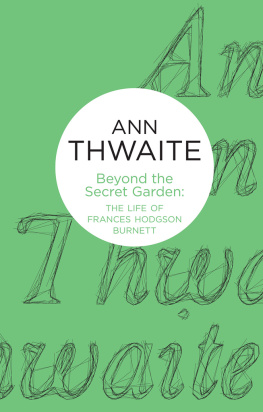
Table of Contents
FROM THE PAGES OF THE SECRET GARDEN
When Mary Lennox was sent to Misselthwaite Manor to live with her uncle everybody said she was the most disagreeable-looking child ever seen. It was true, too.
(page 7)
It had not been the custom that Mistress Mary should do anything but stand and allow herself to be dressed like a doll, but before she was ready for breakfast she began to suspect that her life at Misselthwaite Manor would end by teaching her a number of things quite new to her.
(page 27)
Would you make friends with me? she said to the robin just as if she was speaking to a person. Would you?
(page 36)
I am the first person who has spoken in here for ten years.
(page 65)
Mary was an odd, determined little person, and now she had something interesting to be determined about, she was very much absorbed, indeed. She worked and dug and pulled up weeds steadily, only becoming more pleased with her work every hour instead of tiring of it.
(page 73)
As she came closer to him she noticed that there was a clean fresh scent of heather and grass and leaves about him, almost as if he were made of them. She liked it very much and when she looked into his funny face with the red cheeks and round blue eyes she forgot that she had felt shy.
(page 80)
I am like this always, ill and having to lie down. My father wont let people talk me over either. The servants are not allowed to speak about me. If I live I may be a hunchback, but I shant live.
(page 102)
I dont think I ever really wanted to see anything before, but I want to see that garden. I want the key dug up. I want the door unlocked.
(page 105)
No lad could get well as thought them sort o things.
(page 127)
Hes having one of those tantrums the nurse calls hysterics. How awful it sounds.
(page 136)
Mary! Dickon! I shall get well! And I shall live forever and ever and ever!
(page 164)
She was saying it to Colin because she wanted to make Magic and keep him on his feet looking like that. She could not bear that he should give in before Ben Weatherstaff. He did not give in. She was uplifted by a sudden feeling that he looked quite beautiful in spite of his thinness.
(page 175)
They always called it Magic and indeed it seemed like it in the months that followedthe wonderful monthsthe radiant monthsthe amazing ones. Oh! the things which happened in that garden! If you have never had a garden you cannot understand, and if you have had a garden you will know that it would take a whole book to describe all that came to pass there.
(page 180)
One of the new things people began to find out in the last century was that thoughtsjust mere thoughtsare as powerful as electric batteriesas good for one as sunlight is, or as bad for one as poison. To let a sad thought or a bad one get into your mind is as dangerous as letting a scarlet fever germ get into your body.
(page 214)
By his side with his head up in the air and his eyes full of laughter walked as strongly and steadily as any boy in YorkshireMaster Colin!
(page 227)

FRANCES HODGSON BURNETT
Imagine childrens books as popular as the Harry Potter series is today, and you have some idea of the iconic status Frances Hodgson Burnett earned from her writing more than a century ago. Frances was born in Manchester, England, in 1849. Her prosperous father owned a home-furnishings business, supported by customers made wealthy through the Manchester textile industry. But when her father died in 1853 and then cotton imports ceased when the American Civil War began, Francess family became almost penniless. To survive, her mother moved her five children to rural Tennessee in 1865.
A naturally gifted storyteller, Frances charmed family and friends with her keen imagination. In spite of little formal schooling, she read avidly, and it was not long before she realized she might aid her struggling family by selling stories to popular ladies magazines. She sent her work to Godeys Ladys Book, and in 1868 Godeys published two stories for $35the first of what would be a lifelong stream of handsome paychecks. When her mother died in 1870, Frances was the familys chief supporter, a role she would play throughout much of her life. Indeed, when she married a Tennessee doctor, Swan Burnett, in 1873, it was she who paid their way to Europe so Swan could study medicine.
Within a few years, Frances gave birth to two boys, Lionel and Vivian, and released her first major works, including the critically acclaimed That Lass o Lowries (1877). The conclusion of Lass, in which her characters leave the working-class oppression of the coal-mining culture of Lancashire for a peaceful garden in Kent, introduces an abiding theme for Burnett: the healing power of gardens. Noted by critics as an up-and-coming author, Burnett was also a prominent hostess in Washington, D.C. She was popular and charming, but the numerous roles she playedprolific writer, the familys main breadwinner, mother, wife, and society hostesswere overwhelming at times, as she revealed in her 1883 novel Through One Administration. Yet Burnett loved to work and travel, and she spent considerable time away from her husband and sons. In 1879, shuttling between the United States and Europe, she published a more serious work of fiction, Haworths, which was followed by her first published writing for children, in the magazine St. Nicholas.
Burnett wrote more than fifty novels during her life, but it was the publication of Little Lord Fauntleroy in 1886 that determined the course of her future works and her place in literary history as a writer of childrens fiction. Although the book received an ambivalent critical response, it was a phenomenon in America and Europe, selling out printing after printing and earning Burnett enormous fame and fortune. After the dissolution of her first and second marriages and the 1890 death of her eldest son, Lionel, Burnett wrote the classic for which she is most remembered, The Secret Garden (1911). Its central themethat the mind can heal the bodyreflected Burnetts own struggles with illness and despair. But regardless of the sadness she endured in reality, Burnett was determined to create only happy endings for her characters.
She remained prolific throughout and after World War I, although her Victorian style had become outdated in the eyes of many critics. Surrounded by her family and many friends, Burnett discarded such criticism, writing the successful works T. Tembarom (1913) and The Lost Prince (1915), doing charity work, and tending the luxurious gardens at her homes on Long Island and Bermuda. Frances Hodgson Burnett died of heart failure in Plandome (Long Island), New York, on October 29, 1924.
THE WORLD OF FRANCES HODGSON BURNETT AND THE SECRET GARDEN
| 1849 | Frances Hodgson Burnett is born on November 24 in Manchester , England. Her father, Edwin, owns a home-furnishings shop whose profits provide a good life for his growing family . Henry David Thoreau publishes Resistance to Civil Government , the original title of Civil Disobedience. |
| 1850 | Nathaniel Hawthornes The Scarlet Letter appears. |





